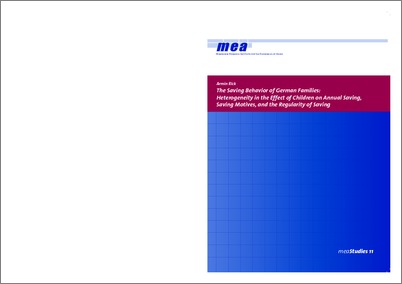|
The Saving behavior of German families : heterogeneity in the effect of children on annual saving, saving motives, and the regularity of saving
Rick, Armin
![[img]](https://madoc.bib.uni-mannheim.de/style/images/fileicons/application_pdf.png)  Vorschau |
|
PDF
MEA_Study_11_Web.pdf
- Veröffentlichte Version
Download (1MB)
|
|
URL:
|
https://ub-madoc.bib.uni-mannheim.de/2841
|
|
URN:
|
urn:nbn:de:bsz:180-madoc-28416
|
|
Dokumenttyp:
|
Arbeitspapier
|
|
Erscheinungsjahr:
|
2010
|
|
Titel einer Zeitschrift oder einer Reihe:
|
None
|
|
Sprache der Veröffentlichung:
|
Englisch
|
|
Einrichtung:
|
Fakultät für Rechtswissenschaft und Volkswirtschaftslehre > Sonstige - Fakultät für Rechtswissenschaft und Volkswirtschaftslehre
|
|
MADOC-Schriftenreihe:
|
Veröffentlichungen des MEA (Mannheim Research Institute For the Economics of Aging) > MEA Policy Brief
|
|
Fachgebiet:
|
330 Wirtschaft
|
|
Normierte Schlagwörter (SWD):
|
Deutschland , Sparverhalten , Familie , Bildungsniveau , Generationsbeziehung
|
|
Abstract:
|
This study investigates education, income and age driven heterogeneity in the effect of children in and outside the household on annual saving, the importance of saving motives, and the regularity of saving, using the 2005-2007 waves of the German SAVE dataset. Children are found to have a negative effect on the level and the regularity of saving, and they appear to intensify the competition among saving motives, shifting the relative importance towards saving for home acquisition, debt reduction, children’s education/support, bequest, and taking advantage of state subsidies at the expense of saving for large purchases, travel, unforeseen events, and oldage provision. When children leave the household, their influence gets usually weaker, but shows more persistence in high education households, at least with respect to the level and the regularity of saving. This is suggested to be a consequence of intergenerational educational immobility and the resulting tendency of highly educated parents to invest more in their children’s human capital. Unfortunately, there is less evidence for educational differences in the effect of children on saving motives - in particular with respect to the motives children’s education/support and bequest - that would reinforce this hypothesis. Household income and, to a lesser extent, the age of the household head appear to alleviate the effect that children have on saving behavior. Instrumenting fertility by exogenous variation created by peer group effects does not indicate that the pattern outlined above is driven by endogenous fertility. When the results are used to adjust life cycle consumption profiles, it is concluded that accounting for the number of children significantly reduces the ‘hump shape’ in consumption and can thus contribute to the explanation of the consumption/income parallel, in particular after the first third of the life cycle.
|
 | Das Dokument wird vom Publikationsserver der Universitätsbibliothek Mannheim bereitgestellt. |
 Suche Autoren in Suche Autoren in
BASE:
Rick, Armin
Google Scholar:
Rick, Armin
Sie haben einen Fehler gefunden? Teilen Sie uns Ihren Korrekturwunsch bitte hier mit: E-Mail
Actions (login required)
 |
Eintrag anzeigen |
|
|
